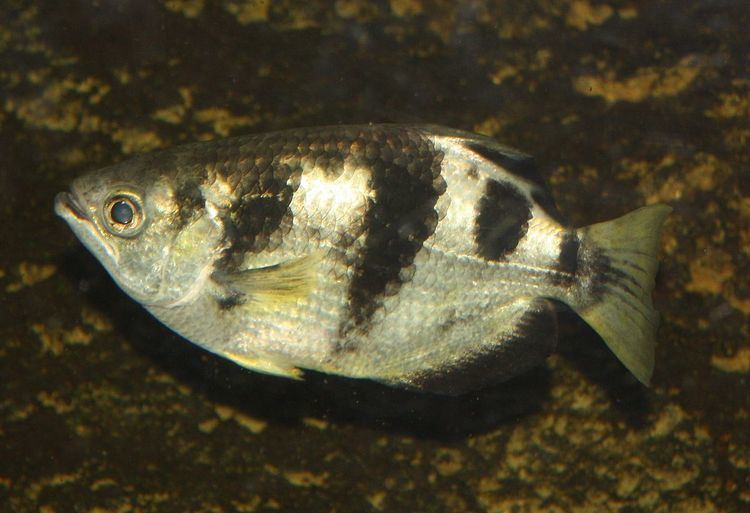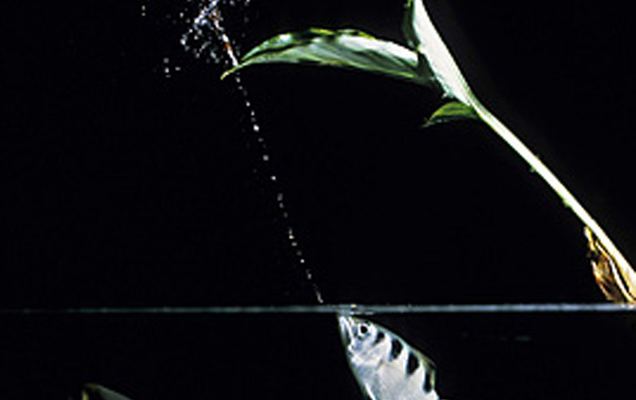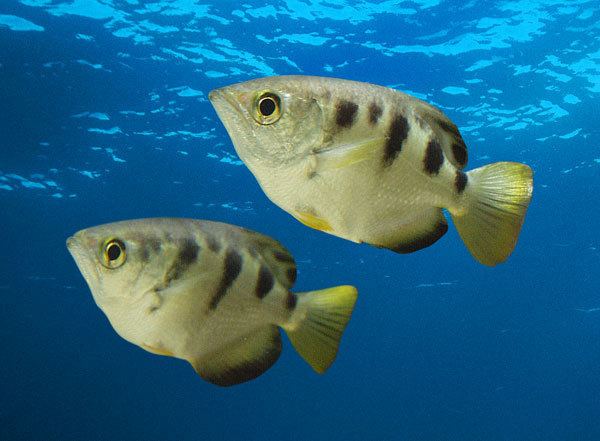Scientific name Toxotes Phylum Chordata | Family ToxotidaeCuvier, 1816 Higher classification Toxotidae Rank Genus | |
 | ||
Similar Toxotes chatareus, Monodactylus argenteus, Gourami, Peters' elephantnose fish, Mudskipper | ||
A fish that spits with perfect aim archerfish in action sciencetake the new york times
The archerfish (spinner fish or archer fish) form a monotypic family,Toxotidae, of fish known for their habit of preying on land-based insects and other small animals by shooting them down with water droplets from their specialized mouths. The family is small, consisting of seven species in a single genus Toxotes. The seven species typically inhabit brackish waters of estuaries and mangroves, but can also be found in the open ocean, as well as far upstream in fresh water. They can be found from India to the Philippines, Indonesia, Australia, and Polynesia.
Contents
- A fish that spits with perfect aim archerfish in action sciencetake the new york times
- Archerfish says i spit in your face deep look
- Capture of prey
- Species
- References

Archerfish or spinnerfish bodies are deep and laterally compressed, with the dorsal fin, and the profile a straight line from dorsal fin to mouth. The mouth is protractile, and the lower jaw juts out. Sizes are generally small,about 5–10 cm, but T. chatareus can reach 40 cm (16 in).

Archerfish are popular for aquaria, but difficult to feed since they prefer live prey.
Archerfish says i spit in your face deep look
Capture of prey

Archerfish are remarkably accurate in their shooting; adult fish almost always hit the target on the first shot. They can bring down insects and other prey up to 3 m above the water's surface. This is partially due to their good eyesight, but also their ability to compensate for the refraction of light as it passes through the air-water interface when aiming for their prey. They typically spit at prey at a mean angle of about 74° from the horizontal, but can still aim accurately when spitting at angles between 45 and 110°.
When an archerfish selects its prey, it rotates its eye so that the image of the prey falls on a particular portion of the eye in the ventral temporal periphery of the retina, and its lips just break the surface, squirting a jet of water at its victim. The archerfish does this by forming a small groove in the roof of its mouth and its tongue into narrow channel. It then fires by contracting its gill covers and forcing water through the channel, shooting a stream that, shaped by its mouthparts, travels faster at the rear than at the front. This speed differential causes the stream to become a blob directly before impact as the slower leading water is overtaken by the faster trailing water, and it is varied by the fish to account for differences in range. It also makes one of the few animals who both make and use tools, as they both utilise the water and shape it to make it more useful to them. Archerfish have been known to send a stream up to 5 metres (16 ft) but can only shoot insect up to 1–2 metres (3 ft 3 in–6 ft 7 in) away due to their limited accuracy. They are also persistent and will make multiple shots if their first one fails.

Young archerfish start shooting when they are about 2.5 centimetres (0.98 in) long, but are inaccurate at first and must learn from experience. During this learning period, they hunt in small schools. This way, the probability is enhanced that at least one jet will hit its target. It has also been determined in an experimental context that archer fish were able to benefit from observational learning by watching a performing group member shoot, without having to practice:
This instance of social learning in a fish is most remarkable as it could imply that observers can ‘‘change their viewpoint,’’ mapping the perceived shooting characteristics of a distant team member into angles and target distances that they later must use to hit.
Archerfish will often leap out of the water and grab an insect in their mouths if it happens to be within reach. Individuals typically prefer to remain close to the surface of the water.
New research has found that archerfish use jets to also hunt underwater prey, such as those embedded in silt. It is not known whether they learned aerial or underwater shooting first, but the two techniques may have evolved in parallel, as improvements in one can be adapted to the other.
